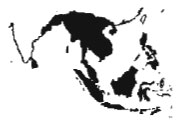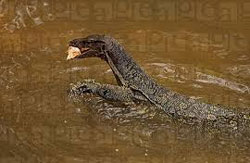Varanus Salvator
Water monitor, Asiatic water monitor.Varanus salvator salvator Laurenti 1788
Varanus salvator cummingi Martin 1838
Varanus salvator nuchalis Gunther 1872
Varanus salvator marmoratus Weigmenn 1834
Varanus salvator bivittatus Kuhl 1820
Varanus salvator logianus Peters 1872
Varanus salvator andamanensis Deraniyagala 1944
 |
The water monitor is said to reach a total length in excess of 3 metres. The largest specimens come from Malaysia, particularly around the Cameron Highlands (Lim 1958; K.han 1969; Anon 1983), where specimens over 250cm TL are sometimes encountered. Jasmi (1988) records that wild specimens can weigh up to 25kg. Thailand is also home to some huge water monitors (Nutphand, Taylor 1963) but elsewhere the water monitor attains smaller sizes; largest found in Java are around 210cm TL, 200cm in Sri Lanka, l70cm in Sumatra and mainland lndia and less than 150cm on the island of Flores (Vogel 1979; Deraniyagala 1953; Werner 1900; Das 1989; Auffenberg 1980). In most areas males reach a larger size than females and probably grow faster and are more active. In most populations sexual maturity is attained around 120cm (females) and 130cm (males), but specimens from India can breed at about 100cm TL (50cm SVL), which they can attain after two years under good conditions.
In tropical areas with abundant food resources water monitors may breed throughout the year. Elsewhere mating and egglaying Occur at the beginning of the wet season. There is surprisingly little data available about the reproductive biology of this lizard in the wild (Biswas and Kar 1981; Erdelen 1988; Gaulke 1989b, 1992). Clutches from large females typically consist of about 15 eggs, but up to 40 may be laid over a year. Nest sites include burrows (especially in elevated, sandy positions), abandoned and active termite mounds and possibly tree hollows (Taylor 1963). Incubation times appear to vary widely, but fully developed eggs may remain dormant for some time and do not hatch until rainfall is plentiful (Nabhitabhata, pers. comm). It has been suggested that females return to nests in active termitaria and release the young after they have hatched (Boonratana 1988). Young water monitors are more brightly coloured than their parents, but show no unusual patterns. They spend most of their time in trees.
Water monitors are active at lower body temperature than most other varanids, and seek out microhabitats that allow them to maintain relatively constant temperatures (Wikramanayake & Green 1989 - see discussion under V.bengalensis). Traeholt (1995) records temperatures of 29.5-37°C with average activity temperatures of 30-31 °C and mean basking time of 38 minutes per day. Their metabolic rates are also lower than those of many other monitors (Gleeson 1981). Most of the day is spent lying in or close to water and in many areas the lizards are most active in the mornings. At night they shelter in tree, burrows or thick vegetation. The burrows of water monitors can be enormous; more than 10 metres long with tunnels large enough for a man to hide in (Traeholt in pressa). During wet seasons the lizards cover much larger areas as the amount of suitable habitat increases (Auffenberg 1980; Erdelen 1988). Traeholt (in pressb) records that populations of water monitors in different habitats display very different activity patterns. Bipedal combat is described by Honneger & Heusser (1969), Vogel (1979), Gaulke (1989b), Rese (1986), Horn (1994) and social hierarchy by Daltry (1991).
Water monitors are among the most easily available varanids in the pet trade, but their enormous size makes them one of the most difficult species to care for properly. Breeding in captivity has been reported many times, but there are few examples of females reproducing consistently (e.g. Honneger 1971; Anon 1981; Bowers 1981; Groves 1984; Hairston & Burchfield 1992; Andrews & Gaulke 1990; Ettling 1992, Jes 1994; Vogel 1994; Andrews 1995). Water monitors are unable to tolerate each other in cramped spaces (Daltry 1991). Courtship and mating are often very violent and finding a compatible pair can be problematic because animals collected from different areas may not respond to each other, but also because females are often much smaller than males and are less commonly collected. Unfortunately there is no way of distinguishing the sexes with certainty without resorting to internal examination. Outside the breeding season the animals must be housed apart in all but the largest enclosures. A minimum of 6m2 is required by each adult. Large pools of water do not seem to be essential, but the animals should be allowed to immerse themselves if possible. Females are particularly aggressive just prior to egglaying. Length of incubation in captivity varies, sometimes even amongst eggs from the same clutch (Kratzer 1973). At 30°C they hatch after 180-327 days. Water monitors grow very quickly and can attain adult size within 30 months given good feeding. A varied diet should be provided and care taken that the animals do not become too fat. Suitable foods in captivity include crabs, fish, molluscs and large insects as well as birds and rodents.
Many sub species of the water monitor have been described and no records of interbreeding between subspecies exist. The Javan water monitor (V.s.bivittatus) is a brightly coloured water monitor, whilst V.s. togianus is a darker form from Sulwesi and adjacent islands (Mertens 1959) and VS.andamanensis is a melanistic race from the Andaman Islands (Deraniyagala 1944. 1961 The name VS.komaini is used to describe many black water monitors that appear in the wildlife trade, but no such subspecies has been formally described and black animals attributed to many subspecies are known from many coastal regions (Bennett 1995b). The differences between the subspecies on the Philippine Islands are the best documented (Gaulke 1986" 1989b, 1991b, 1992a&b). The Philippine water monitor (V.s.masmoratus) inhabits south Luzon, Samar, Ticao, Palawan, Calamian, Sogon, Mindoro and the islands of the Sulu Archipelago as far as eastern Borneo. It reaches a size of about 80cm SVL (200cm TL). The rough-necked water monitor V.S.llnuchalis attains a maximum size of about 60cm SVL and is distinguished by its large neck scales. It lives on Cebu, Ticao, Negros. Panay and Masbate and may have been confused with the rough-necked monitor on some occasions. Specimens from Masbate are particularly dark. The beautiful Cuming's water monitor (Vs.cumingi) is found on Mindanao, Samar, Layte, Bohol and Basilan and reaches a maximum size of about 70cm SVL (150cm TL). It does not appear to be closely related to the other races and may have different origins. Animals of a similar appearance have been collected from the eastern coast of Borneo. Water monitors from the remainder of the range are usually known as V.salvalor salvator, but a biochemical study of the relationship between races of this remarkable animal would probably reveal some surprises. For captive breeding attempts it is highly desirable that both members of the pair have the same geographical origins. Populations at the eastern end of the range appear to be suffer particular heavy infestations of skin parasites, which make holes in the hides and greatly reduce their commercial value (Luxmoore & Groombridge 1990).
On Bali the water monitor is known as alu, on Flores as weti. Elsewhere in Indonesia and in Malaysia they are known as biawak air. In Thailand they are known as hiah, but this word is considered offensive by many people and the term Tua-nguen-tua-tong (a creature of silver and gold) is best used with strangers. In Sri Lanka they are called karabagoya, in the Philippines Halo, in Bengali ram godhika and in Bangladesh (where they are rare) as pani gudhi or pani goisap.
Attribution / Courtesy: Daniel Bennett. 1995. A Little Book of Monitor Lizards. Viper Press U.K.





